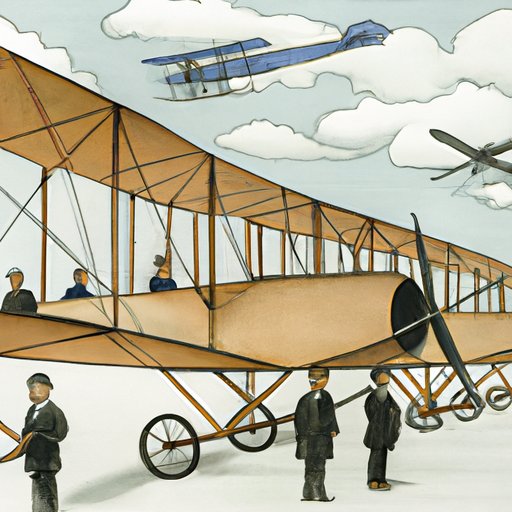Introduction
The invention of the airplane was a monumental achievement that changed the world forever. An airplane is defined as “a powered heavier-than-air aircraft with fixed wings, for gliding or propulsion through the air.” This article will explore the history of the airplane, from its earliest experiments to its modern designs, and examine the contributions of the inventors who helped make it possible.

A Historical Look at the Inventors of the Airplane
The history of the airplane dates back to the late 1700s when the first attempts at flight were made. Early pioneers such as Sir George Cayley and Jean-Marie Le Bris experimented with gliders, while inventors like Alphonse Penaud, John Stringfellow, and Clement Ader built model airplanes powered by rubber bands and steam engines.
However, it was the Wright brothers – Wilbur and Orville – who are credited with being the first to make a successful controlled, powered, and sustained flight of a heavier-than-air machine in 1903. The Wright brothers worked together to build their plane, which they called the Flyer, and made several improvements on existing technology. They also conducted a series of tests over a period of years to perfect their design.
While the Wright brothers are often considered the inventors of the airplane, there were other inventors involved in developing the plane. These include Otto Lilienthal, Lawrence Hargrave, Samuel Pierpont Langley, and Glenn Hammond Curtiss. Each of these inventors made significant contributions to the development of the airplane, and their work laid the foundation for the modern designs we have today.
Exploring the Contributions of the Wright Brothers to Aviation
The Wright brothers are widely regarded as the inventors of the airplane, and their achievements in aviation are unparalleled. Their experiments focused on creating a controllable, stable aircraft, and they developed several innovative techniques to do this, including warping the wings to maintain balance and using a system of pulleys to control the plane.
They also tested their designs extensively, conducting over 1,000 flights before their first public demonstration in 1908. This was a major breakthrough for aviation, and their success inspired others to continue their work. Today, the Wright brothers are remembered as pioneers in the field of aviation, and their legacy lives on in the modern designs of airplanes.

Examining the Role of Other Inventors in Developing the Plane
Although the Wright brothers are credited with inventing the airplane, they weren’t alone in their efforts. Otto Lilienthal was an early pioneer in aviation who studied the principles of flight and experimented with gliders. He made a series of successful glider flights, and his work was a major influence on the Wright brothers.
Lawrence Hargrave was another inventor who contributed to the development of the airplane. He conducted experiments with kites and gliders and developed the box kite, which was an important design element used in the Wright brothers’ Flyer.
Samuel Pierpont Langley was another key figure in the development of the airplane. He was the first to successfully fly a powered, heavier-than-air machine, although it was not a practical design. His experiments, however, were influential in the development of the modern airplane.
Finally, Glenn Hammond Curtiss was an aviation pioneer who developed the first practical seaplane, which was used by the U.S. Navy. He also designed the first successful tractor biplane, which was an important step in the development of the modern airplane.

The Evolution of Airplanes: From Early Experiments to Modern Designs
Since the invention of the airplane, there have been many advances in technology that have improved the design and performance of aircraft. Jet engines were developed in the 1940s, allowing for faster, more efficient flight. Autopilot systems were introduced in the 1950s, making it easier to control the plane. And in the 1970s, safety features such as seatbelts and airbags were added to improve passenger safety.
Today, airplanes are a common form of transportation, used for both commercial and private travel. They have come a long way since their invention, and the advances in technology have made them safer, faster, and more reliable than ever before.
Conclusion
The invention of the airplane was a revolutionary moment in history, and it has had a profound impact on society. While the Wright brothers are often credited with inventing the airplane, they weren’t alone in their efforts. Other inventors, such as Otto Lilienthal, Lawrence Hargrave, Samuel Pierpont Langley, and Glenn Hammond Curtiss, also played an important role in developing the plane.
The airplane has come a long way since its invention, and modern designs incorporate a variety of advanced technologies. As technology continues to advance, the possibilities for the future of aviation seem endless.
(Note: Is this article not meeting your expectations? Do you have knowledge or insights to share? Unlock new opportunities and expand your reach by joining our authors team. Click Registration to join us and share your expertise with our readers.)
